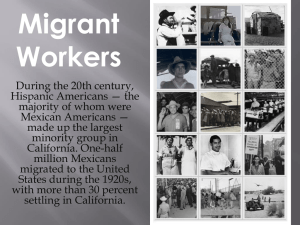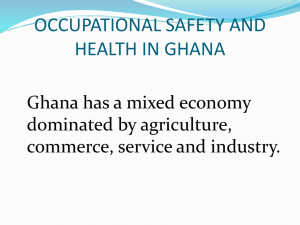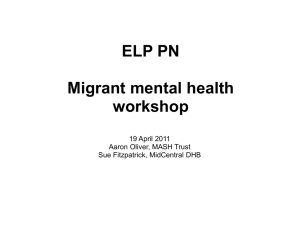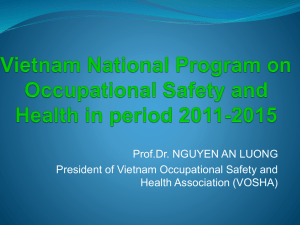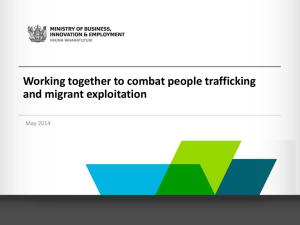English - European Agency for Safety and Health at Work
advertisement
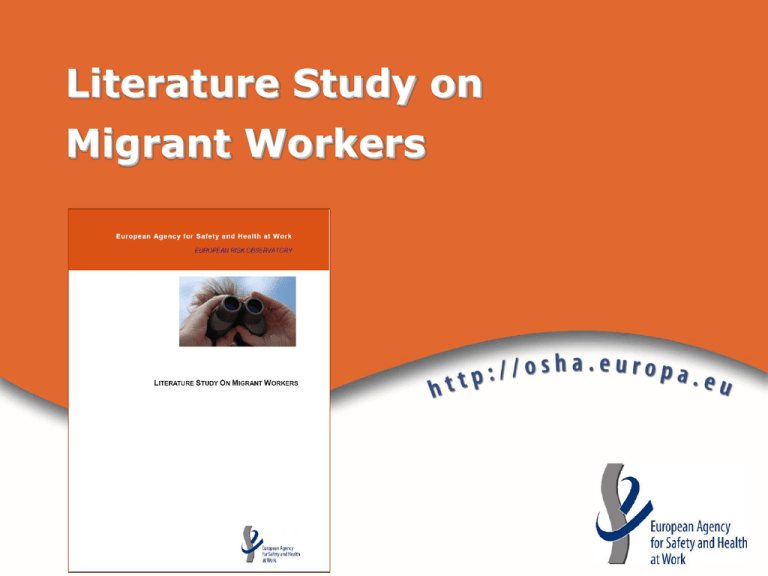
Literature Study on Migrant Workers Content Introduction Overview of migration in different EU countries OSH of migrant workers Actions directed to migrant workers Conclusions Introduction Growing concern about migrant workers’ OSH across the EU27 ERO literature survey to: Reflect current state of knowledge Suggestions for future work by the Agency Carried out by TCRO: FIOH, BAuA, BGIA, CIOP-PIB, INSHT, Prevent Overview of migration in different MS Focus on OSH Actions aimed at migrant workers Overview of migration in different EU countries-1 Broad definition: EU27 nationals (migrants) vs. non EU27 nationals (immigrants). However, both terms used interchangeably. Migrants not always at risk regarding their OSH. Very heterogeneous group. Reasons for migration, legal status and language knowledge have direct impact on their working conditions. Overview of migration in different EU countries-2 Often described as three waves: 1950s & 1960s: mass migrations to some EU countries to meet labour shortages; mostly single males; 1970s: family reunification. Some MS grant legal rights to migrant workers’ families. They form distinct communities in many MS 1980s: post-industrial migration. The result of global economic inequalities, ageing EU population, etc. Overview of migration in different EU countries-3 Percentage shares of foreign citizens in Europe, 2008. Eurostat, 2010 % of foreign citizens within total EU27 6.2 % of foreign citizens within total Italy 5.8 Austria 10.0 Belgium 9.1 Lithuania Bulgaria 0.3 Luxembourg 42.6 15.9 Latvia 18.3 Czech Republic 3.3 Malta 3.8 Germany 8.8 Netherlands 4.2 Denmark 5.5 Poland 0.2 Cyprus Ireland 12.6 1.3 Estonia 17.1 Portugal 4.2 Greece 8.1 Romania 0.1 11.6 Sweden 5.7 Finland 2.5 Slovakia 0.8 France 5.8 Slovenia 3.4 Hungary 1.8 UK 6.6 Spain http://epp.eurostat.ec.europa.eu/portal/page/portal/population/data/main_tables OSH of migrant workers-1: Employment Higher unemployment rates, and Market segmentation: Concentration in certain sectors. Split between: high-skilled, specialist jobs (e.g., ICT) and “3-D jobs” (dirty, dangerous and demanding): agriculture & horticulture, construction, health care, households, transport, food sector High work uncertainty; poor working conditions; part time jobs; low wages; over-qualification; often more exposed to harassment and violence; OSH of migrant workers-2: Over-qualification Over-qualification rates (%) of native/foreign born population, 2004. Source OECD, 2006 Native-born Foreign-born Austria 10.3 21.1 Belgium 15.6 21.6 5.2 10.0 Germany 11.4 20.3 Denmark 10.4 18.6 9.0 39.3 Spain 24.2 42.9 Finland 14.3 19.2 France 11.2 15.5 6.3 9.7 15.7 23.8 Italy 6.4 23.5 Luxembourg 3.4 9.1 Norway 8.4 20.3 Portugal 7.9 16.8 Sweden 6.5 16.1 15.3 17.8 Czech Republic Greece Hungary Ireland UK OSH of migrant workers-3 Why this segmentation? Labour shortages Language/legal barriers Discrimination OSH outcomes: difficult to analyse due to market segmentation but worrying in any case OSH of migrant workers-4 Additional OSH risks for migrant workers: Short time in host country Limited knowledge of H&S systems in place Racial harassment: consistent finding, regardless of sector/occupation effect. Undeclared workers: under-reported, worse working conditions, unaware of their rights Actions directed to migrant workers Belgium: Finland: ORCA guide for undeclared workers (OSH) OSH Inspectorate monitors conditions of migrant workers Netherlands: - Labour Ministry guide on safety for migrant workers in construction - ARBO platform: language - National Office for Discrimination: training on discrimination against migrant apprentices Spain: Murcia. OSH materials translated into different languages (construction, agriculture). UK: HSE and TUC translated OSH materials into 21 languages Conclusions Lack of strong data: very few studies directly address migrant workers’ OSH The existing information gives enough cause for concern Important to: identify priorities for action improve data collection & research disseminate existing good practices Migrant workers More information available at: Agency information on migrant workers: http://osha.europa.eu/en/priority_groups/migrant_workers/ Publication: http://osha.europa.eu/en/publications/literature_reviews/mi grant_workers/view European Risk Observatory: http://riskobservatory.osha.europa.eu European Agency for Safety and Health at Work: http://osha.europa.eu/ Thank you for your attention!
